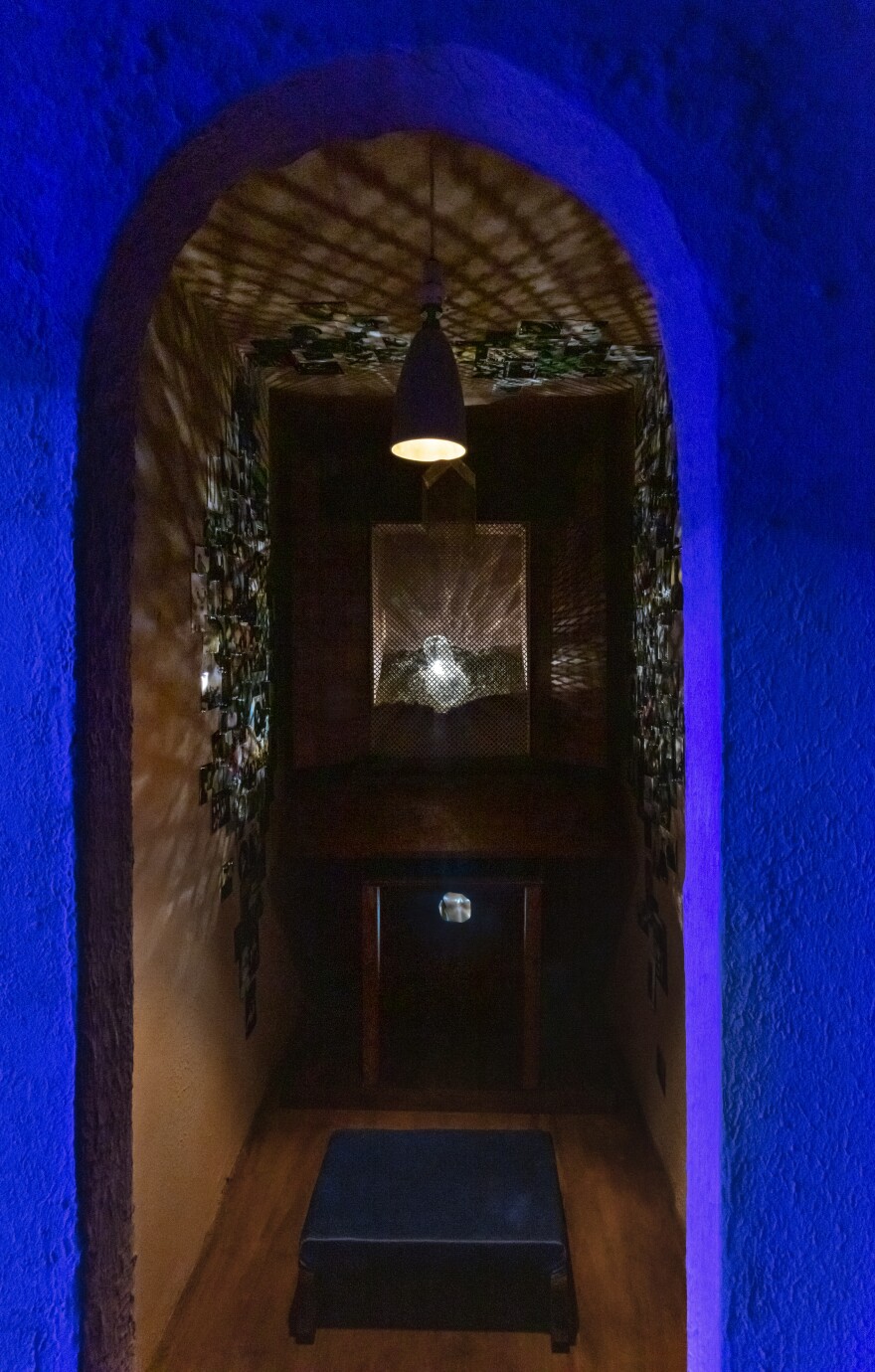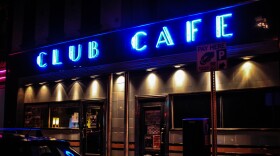In 2014, Shikeith Cathey came to Pittsburgh for an artist residency that would alter the course of his career. A few years later, the Philadelphia native – then gaining a national reputation – moved here. In 2021, he’s still in Pittsburgh, and still building a career that’s higher-profile than ever as he continues to explore Black male queer lives.
Shikeith's "Feeling the Spirit in the Dark" continues through June 21. The Mattress Factory, 500 Sampsonia Way, North Side
Shikeith – he goes by his first name – currently has installations up at three prominent U.S. museums, including Pittsburgh’s own Mattress Factory, where his multi-part work “Feeling The Spirit in the Dark” is by turns contemplative and provocative. He’s also rising in prominence among art-world tastemakers.
“There’s absolutely a building momentum that is happening,” said Lesley Martin, creative director for the New York-based Aperture Foundation, whose avant-garde photography quarterly, “Aperture Magazine,” has featured Shikeith’s work. “I think what we’re looking at and waiting to see is when Shikeith is going to have that moment for himself. … It’s just on the horizon, I’m sure.”
"We usually don't see pictures of black men loving one another"
Shikeith, now 31, first came to Pittsburgh for a residency at Bunker Projects, an independent art space in Bloomfield. A few years earlier, in 2010, he had graduated from Penn State, and he had already begun making a name in photography, with images depicting Black men as vulnerable, playful, and beyond stereotypes of masculinity.
“We usually don’t see pictures of Black men loving one another. Sad to say, but it felt astounding at the time,” said LaTanya S. Autry, a curator at the Cleveland Museum of Contemporary Art. “It was work that was very tender, very spiritual, very emotional.”

Around the same time, Shikeith released online his short experimental documentary “#blackmendream.” It features nine speakers with their backs to the camera, some of them partly unclothed or naked, telling about their lives as young Black men in America. The anonymous interviewees spoke unguardedly about how they’d never been taught to express emotion, and how the same attitude of toughness they felt their own communities expected of them led to ostracism by wider society.
“The project was pointed towards just getting people to talk about what was going on in the world,” said Shikeith. “A lot of Black male culture is steeped in a sort of restraint, and that restraint involves a lack of emotionality, which is sort of a symptom of toxic masculinity.”
The video -- released not long after the killings of Travyon Martin and Michael Brown -- went viral. It screened at festivals and venues including New York’s Museum of Modern Art, and drew national press.
But Shikeith’s revelation in Pittsburgh concerned another artistic medium entirely. During his Bunker Project residency, he visited the Mattress Factory, which specializes in room-sized installation art. His own first sculptural installation followed, at Bunker. Titled “the moment you doubt whether you can fly, you cease for ever to be able to do it,” it consisted of a life-sized human form made of black plaster emerging from a bed of soil on the gallery floor, while holding a black balloon that floated above.
“From there on, it sort of just become a huge part of my practice, in terms of creating these environments, creating these large-scale installations,” said Shikeith.
"I knew this was the place I needed to be to sort of begin things"
Shikeith enrolled in graduate studies at the Yale School of Art to study sculpture; he graduated, in 2018. Recalling the support he’d received here, he moved to Pittsburgh.
“I knew this was the place I needed to be to sort of begin things,” he said.
Shikeith lives in Friendship, but he’s frequently on the road with his exhibitions. He’s been in group shows all over the U.S. and solo exhibits as far afield as MAK Gallery, in London. Writing about that show, American critic Antwaun Sargent contended that Shikeith’s central question, as a Black man who lives outside the culture’s masculine ideal, is “When will I ever be comfortable in my own skin?”
Currently, the California African American Museum is featuring Shikeith in “Enunciated Life,” a group show exploring Black spiritual life.
“Shikeith has this thread that runs throughout his entire work of thinking about black male queerness and the desires that sort of permeate and are generated in black male queer spaces,” said Taylor Renee Aldridge, the exhibit’s curator. Shikeith’s life-sized wooden structure “Sermon for Longing in Blue” evokes both the interiors of Black churches and the blue-lit basement parties thrown by black queer men, she said. “He sees similarities between the desire to be intimate with the Holy Spirit and the desire to be intimate with other bodies and other people.”

At the Cleveland Museum of Contemporary Art, “Imagine Otherwise,” a show responding to anti-Black violence, includes Shikeith’s “still waters run deep / fall in your ways.” The two-part installation employs poetry, music, historical narratives and projected video alongside a centerpiece that evokes a ship, complete with sail, said curator LaTanya S. Autry.
“It’s a real multiplicity of ideas, and seeing that the images are projected on the sail, they do spill off onto the walls,” said Autry. “And the images are reflected in the water.” However, she added, “It’s also got this extremely stark, very sheer quality. He’s stripped it down to just what it has to have.”
(Autry knew Shikeith when he was at Yale, where she then worked for the university’s art gallery; she said that when she interviewed at Cleveland MOCA for the fellowship that preceded her permanent job there, “I talked about him in the job interview. I was like, ‘Shikeith, I want to do an exhibition with Shikeith.’”)
Shikeith’s photographs are also featured in an online “viewing room” at New York’s Yossi Milo Gallery.
At the Mattress Factory – the very place where Shikeith was first inspired to create installation art -- “Feeling the Spirit in the Dark” opened last fall. Artist and University of Pittsburgh professor Delanie Jenkins was on the selection committee that chose Shikeith as one of seven artists to create work for the museum this season. She cites simply “the power of his work.”
Other contemporary artists also offer alternate visions of Black masculinity, from renowned painter Kehinde Wiley – the Barack Obama portraitist known for his use of Old Masters iconography and floral backgrounds – to widely exhibited painter and Carnegie Mellon University professor Devan Shimoyama. And other queer Black photographers explore similar terrain.
"Shikeith has this thread that runs throughout his entire work of thinking about the desires that sort of permeate and are generated in black male queer spaces"
Jenkins described Shikeith as “this new kind of voice that was forming through all the different media he was using.”
The title of his Mattress Factory show is inspired by both a song on an Aretha Franklin album of the same name and E. Patrick Johnson’s book “Feeling the Spirit in the Dark: Expanding Notions of the Sacred in the African-American Gay Community.” The exhibit consists of four works in the museum’s Monterey Street annex.
For the title work, Shikeith filled a small, second-floor room with a shallow pool of water that laps against a small wooden pier. The room is suffused with original music by his frequent collaborators Trapcry and Corey Staggers, and bathed in a dim, deep blue light that Shikeith calls “haint blue.” The tone traces to enslaved people in the Old South who used it on the exteriors of their homes to keep away evil spirits. The water, he said, symbolizes both the terrors of the Middle Passage and the purification of baptism.
“These blue spaces essentially point toward the ways water has been a huge part of the way Black people in general have sought freedom, sought reconciliation,” Shikeith said.
The adjoining gallery houses “Altar (Held After),” which is built around a church kneeler. Above, and behind a confessional screen, lies a glass sculpture, lit from within; below, a small peephole displays silent, found erotic videos of Black men, among other imagery, including baptisms and scenes of the ocean. Shikeith said the work draws its power from the juxtaposition of architectural forms.

“I am colliding them to create a mixture to sort of talk about Black queer expression as it relates to both religion, but then also other sort of modes, like pleasure,” he said. “Here we have a mixture of a confessional and a glory hole."
“I like to work with what I call a sort of lowliness, of sort of locating the underground, or the down below, as a site for transformation,” he added. “We can think of many histories of where Black people have gone underground, or down below, to seek out those freedoms, and also queer people in particular, thinking about the underground clubs and cultures of queer life that I’m sort of constructing space around.”
A third-floor gallery houses his room-sized work “The Beauty of Recovering What Has Been Lost.” In the dimly lit room, seven glass sculptures of phalluses hang from the ceiling. They are arranged like stars in the form of the Big Dipper, and each glows from within.
“I think a lot about the idea of sort of holding things in suspension, and the effect of that. But then also, the stars, of course, and gazing at the stars. But then there’s also the parallel of scenes of lynchings, where Black men were castrated,” said Shikeith. “Within a lot of my work I like to address the violent histories, while also pointing towards other pathways or routes of escape.”
The ambient sound is provided by Corey Staggers, playing a solo saxophone version of the jazz standard “Round Midnight.”
“‘The Beauty of Recovering What Has Been Lost’ is in a way oscillating back and forth between those histories of violence, but also the pleasures of seeking freedom through the stars,” he said.














